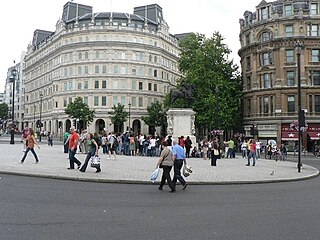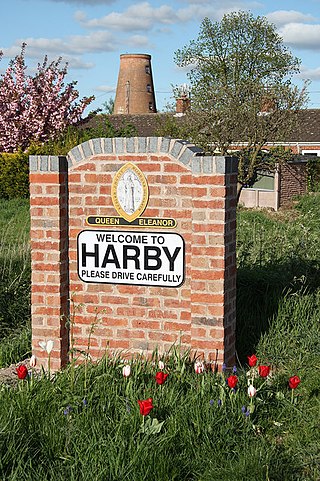
Lincoln is a cathedral city and district in Lincolnshire, England, of which it is the county town. In the 2021 Census, the Lincoln district had a population of 103,813. The 2021 census gave the urban area of Lincoln, including North Hykeham and Waddington, a recorded population of 127,540.

Charing Cross is a junction in Westminster, London, England, where six routes meet. Since the early 19th century, Charing Cross has been the notional "centre of London" and became the point from which distances from London are measured. Clockwise from north, the routes that meet at Charing Cross are: the east side of Trafalgar Square leading to St Martin's Place and then Charing Cross Road; the Strand leading to the City; Northumberland Avenue leading to the Thames Embankment; Whitehall leading to Parliament Square; The Mall leading to Admiralty Arch and Buckingham Palace; and two short roads leading to Pall Mall.

The Eleanor crosses were a series of twelve tall and lavishly decorated stone monuments topped with crosses erected in a line down part of the east of England. King Edward I had them built between 1291 and about 1295 in memory of his beloved wife Eleanor of Castile. The King and Queen had been married for 36 years and she stayed by the King’s side through his many travels. While on a royal progress, she died in the East Midlands in November 1290, while suffering from a strain of malaria.. The crosses, erected in her memory, marked the nightly resting-places along the route taken when her body was transported to Westminster Abbey near London.
St. Catherine or St. Katherine may refer to a number of saints named Catherine, or:

Metheringham is a village and civil parish in the North Kesteven district of Lincolnshire, England. The population of the civil parish at the 2011 census was 3,605. It is about 9 miles (14 km) south of Lincoln and 10 miles (16 km) north of Sleaford. The centre of the village is a conservation area.

Eleanor of Castile was Queen of England as the first wife of Edward I. She was well educated at the Castilian court. She also ruled as Countess of Ponthieu in her own right from 1279. After intense diplomatic manoevres to secure her marriage to affirm English sovereignty over Gascony, she was married to Prince Edward at the monastery of Las Huelgas, Burgos, on 1 November 1254, at 13. She is believed to have had a child not long after.

Bracebridge Heath is a village and civil parish in the North Kesteven district of Lincolnshire, England. It is 2 miles (3 km) south of Lincoln and straddles the border with the Lincoln and North Kesteven district boundaries.
Lincolnshire is a large county in England with a sparse population distribution, which leads to problems funding all sorts of transport. The transport history is long and varied, with much of the road network still based on the Roman model, and the once extensive rail network a shadow of its former self.

Harby is a village and civil parish in the Newark and Sherwood district of Nottinghamshire, England. It is close to Doddington, Lincolnshire, and is the easternmost settlement in Nottinghamshire, the boundary separating the two. According to the 2011 census, it had a population of 336, up from 289 at the 2001 census. It increased to 346 at the 2021 census.

Delapré Abbey is a neo-classical mansion in Northampton, in Northamptonshire, England.

The Priory Academy LSST is a co-educational non-selective academy school and teaching school situated on Cross O'Cliff Hill, Lincoln, Lincolnshire, England. It specialises in science, technology and teaching, and is the lead school of the Lincolnshire Teaching Schools Alliance. It is also the lead member of The Priory Federation of Academies.
Lincolnshire is one of the few counties within the UK that still uses the eleven-plus to decide who may attend grammar school, in common with Buckinghamshire and Kent.

Alexander of Abingdon, also known as Alexander Imaginator or Alexander le Imagineur, was one of the leading sculptors of England around 1300.

Bracebridge is a suburb of Lincoln, Lincolnshire, England. It is situated approximately 2 miles (3 km) south from the city centre on the main A1434 Newark Road, stretching approximately from St Catherine's to Swallowbeck alongside the east bank of the River Witham, and the village of Bracebridge Heath.

St Mary Magdalene was a Benedictine priory in Lincoln, England. Along with Sandtoft Priory and Hanes Cell, it was a Lincolnshire cell of St Mary's Abbey in York, England. A surviving building, once owned by the priory, is Monks' Abbey, Lincoln.
St. Katherine's Priory also known as The Priory of Saint Katherine without Lincoln was a Gilbertine priory of Canons Regular on the Fosse Way just outside the walls of Lincoln, England. The Priory ran the Hospital of St Sepulchre, probably the first hospital in the city.

The following is a timeline of the history of the city of Lincoln, the county town of Lincolnshire in the East Midlands of England.

St Katherine's Church, Lincoln also known as "Southside" and "St Katherines Cathedral Church" is a Grade II-listed church in Lincoln, Lincolnshire, England. It is a former Methodist church in the Boultham and St Catherine's areas of the city. It was first opened in 1887 with the tower and spire being added later. During its use as a place of worship, it was dubbed "Lincoln's second cathedral.

Lincoln City Centre is the central business district of Lincoln in Lincolnshire, England. It is defined as the areas along directly north of city's High Street. Each part of the centre brings a differing main sector or sectors to the city with a small overlap between each area.















